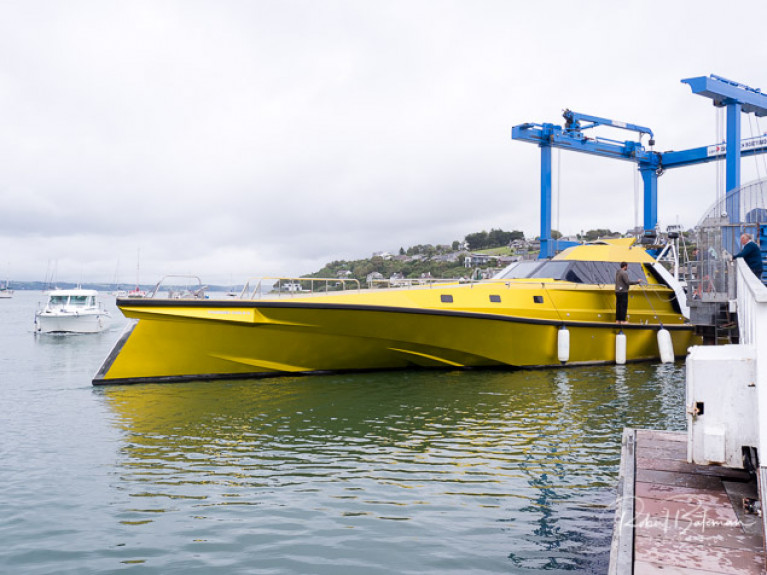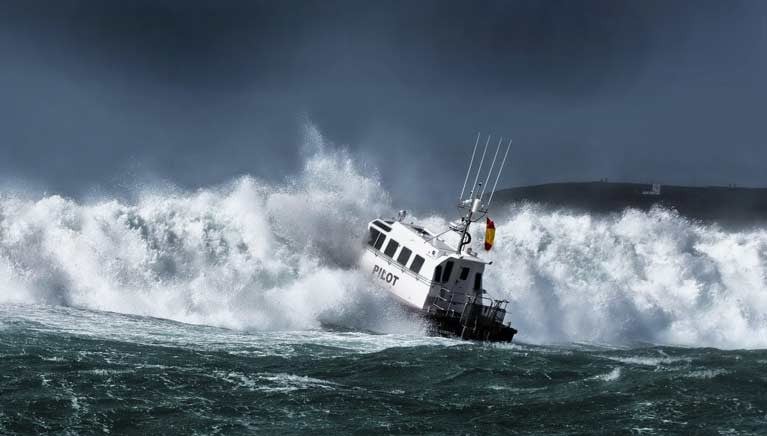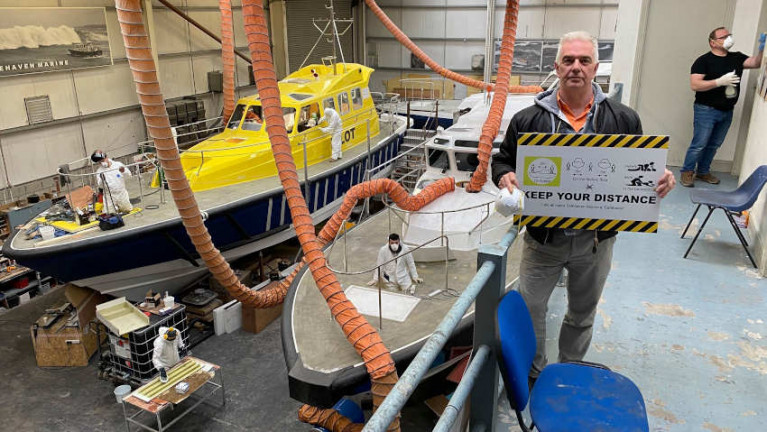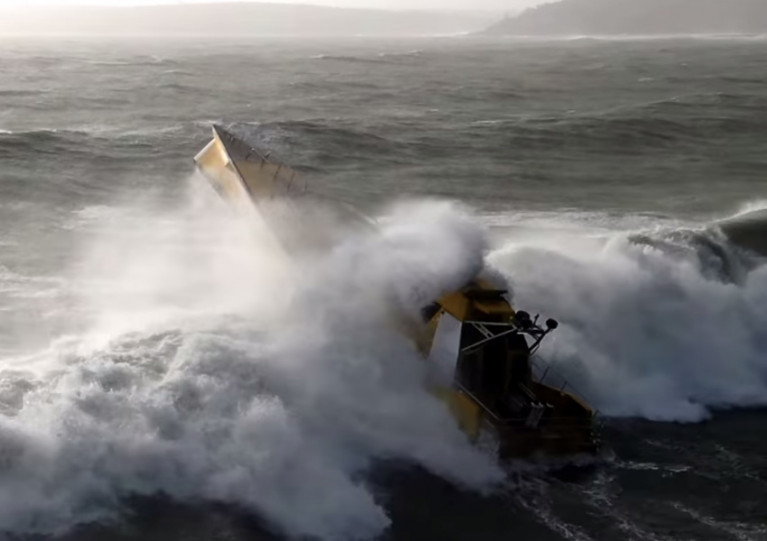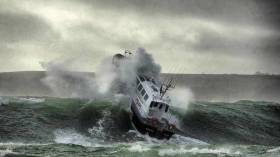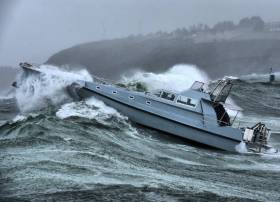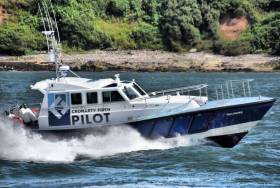Displaying items by tag: Safehaven Marine
The fully refurbished Thunderchild II was on the hoist at Crosshaven Boatyard in Cork Harbour yesterday, fuelling speculation that she is preparing for a new world record transatlantic crossing?
As regular Afloat readers will know, the record bid for the innovative Irish craft was postponed from 2019 until this summer.
The North Atlantic Challenge by Safehaven Marine of Youghal’s new 70ft XSV20 Thunder Child II was originally scheduled to be underway in mid-July 2019. But although the boat had her preliminary launch that February, pressure of work on other craft in the company’s internationally successful pilot and patrol boat ranges at the busy factory saw a postponement of the Challenge until 2020. And while the preferred strategy is still in favour of the northern route, the plan now is to do it west to east.
Designed and built by Youghal-based Safehaven Marine, managing director Frank Kowalski describes the super-swift craft as “a unique, hybrid hull design, asymmetrical catamaran, with a wave-piercing deep V mono-hull”.
Valued at over €1m, it is designed for high speed, with minimal turbulence.
Measuring 23 m in length, it has a 5.3 m beam and boasts a Hyuscraft hydrofoil system fitted between the two catamaran hulls.
In July 2017 the 17-metre original Thunder Child set a record in circumnavigating Ireland, anticlockwise, via Rockall, in just over 34 hours.
It was previously indicated that between July and August 2020 the same five-member crew, aboard Thunder Child II will attempt an unprecedented 4,500 km transatlantic route from Killybegs to Newfoundland via refuelling stops at Greenland and Iceland.
Cork Boat builder Safehaven Marine Ready to Deliver Interceptor 42 Pilot Boat to Northern Spain
Safehaven Marine have launched ‘San Cibrao’, an Interceptor 42 pilot boat for the port of San Ciprian in Spain.
San Cibrao is the 14th pilot 42 model built and the 43rd Pilot vessel Safehaven Marine have delivered to ports worldwide and has proved to be a superb sea boat performing admirably in pilotage operations with all owners extolling its virtues of seakeeping, strength and stability. San Cibrao is powered by a pair of Volvo D9 engines rated at 425hp and has a maximum speed of 23.5kts. She is heavily fendered all round and incorporating Safehaven’s sacrificial fender system protecting the vessel at her boarding area and softening the inevitable hard impact that can occur in poor conditions.
 (Above and below Safehaven's Interceptor 42 handling winds of 50kts at the entrance to Cork Harbour with 4-metre heavily breaking seas offshore in the shoaling waters off the Daunt Rock
(Above and below Safehaven's Interceptor 42 handling winds of 50kts at the entrance to Cork Harbour with 4-metre heavily breaking seas offshore in the shoaling waters off the Daunt Rock


Safehaven’s proven MOB recovery system is fitted on the transom allowing a casualty to be easily recovered in a MOB situation. A full suite of Furuno electronics are installed at her central helm position and she provides seating for 4 pilots on CAB suspension seats in her very highly fitted out the main cabin, which provides a comfortable relaxed environment for pilots and crew during transfers with additional accommodation in her f/wd cabin incorporating seating and berths, a separate heads compartment, dedicated electrical room and galley area.
With the Covid-19 travel restrictions in place and the Pilots from San Ciprian unable to fly here at present, so Safehaven is having to do a remote ‘on-line handover’. So Safehaven produced a video to give them every confidence that she is performing well, as she handled comfortably the stormy conditions prevailing on the South Coast of Ireland during trials, with winds of 50kts at the entrance to Cork Harbour, and over 4m heavily breaking seas offshore in the shoaling waters off the Daunt Rock, presenting the exact heavy weather conditions she was designed and built for:
As the pilots in San Ciprian have to deal with the challenging seas of the Bay of Biscay in wintertime, Safehaven wanted to ensure she was up to the task. She is due to be shipped overland shortly where she is needed urgently to ensure essential pilotage to ships entering and departing the Port in Northern Spain.
Safehaven currently has in build pilot boats for the Ports of: Coruna Spain, Gdynia, Poland, Montevideo, Uruguay and Tangier, Morocco and have this month, May 2020 signed contracts with the Faroe Islands Rescue service to supply a second Interceptor 48 S.A.R. craft.
Safehaven Marine has emerged from ‘lockdown’ with the launch of its new pilot boat for the Port of San Ciprian in Spain.
The Cork-based performance boat specialists put production on pause at the end of March, following strict Government restrictions on movement against coronavirus.
Almost completed at the time was the Interceptor 42 order for the fishing port in north-western Spain.
But as Safehaven tweeted yesterday, the boat is finally on the water for initial sea trials as the country begins its gradual reopening.
Safehaven Marine made the deal with the Spanish port — along with orders for Coruna, and Leixoes in Portugal — over a year ago, and more news is expected from the boatyard in the coming weeks.
Another recent delivery delayed by Covid-19 restrictions is an Interceptor 38 to the Port of Berbera in Somaliland, which was received in mid April.
Great to launch a new pilot boat for the Port of San Ciprian in Spain after nearly 2 months of Lockdown. She was nearly finished at the start of the lockdown and it was nice to be on the water again, even with social distancing @AfloatMagazine @LarryCpix @captainbob76 @MaryP972 pic.twitter.com/QqsEwhP31t
— Safehaven Marine (@SafehavenMarine) May 19, 2020
Safehaven Marine Adapts To New Requirements
New restrictions prompted by Covid-19 require new ways of working for Irish businesses, and until the most recent measures announced by the Government, Safehaven Marine in Cork was among those rising to the challenge.
The performance boatbuilder spread out its production over two large factories, with staff divided into split morning and evening shifts, so that physical distancing was maintained as work continued.
Other measures included limiting staff to no more than three inside a boat at any one time, split meal breaks to rule out social grouping, and regular and rigorous disinfection of more highly trafficked areas on the workshop floor, as well as daily temperature readings for all staff.
“Everybody’s positive and banding together supporting each other’s efforts in making Safehaven Marine a little safe haven,” said the company in a recent social media post. “What a great workforce we have. Hopefully we’ll get through it OK.”
Safehaven also recently bade farewell to two pilot boat commissions on their respective journeys to Berbera in Somaliland, and San Juan in Puerto Rico.
The latter Interceptor 48 was featured by Safehaven Marine two months ago after undergoing sea trials alongside Thunder Child II off a stormy Cork coast.
Update Tuesday 7 April: An earlier version of this story inferred incorrectly that work was continuing at Safehaven Marine after the most recent extension of Covid-19 restrictions. Afloat.ie would like to make clear that Safehaven Marine is of the understanding that it is not an essential business and has since paused its workshop operations in the interest of employee and public safety.
Sea Trials For Safehaven Marine’s Latest Pilot Boat
Safehaven Marine’s pilot boat for Puerto Rico has undergone sea trials off the Cork coast ahead of delivery — and Thunder Child II was with it in the swell to capture the action (also caught from above by drone — see video below).
Commissioned in late 2018, the Interceptor 48 is the 41st pilot vessel (and 17th in its line) produced by the Cork Harbour firm, which builds its boats in Youghal.
Thunder Child II was put through its own paces last month during Storm Brendan as its prepped for a new west-east transatlantic record attempt later this year.
Recent sea trials of San Juan’s Pilot 48 with Thunder Child II as camera boat, some beautiful aerial drone footage of the two boats running side by side @captainbob76 @MaryP972 @corkharbour @urlofcork @EoinBearla @barrabest @whatrobdidnext @AfloatMagazine @PaschalSheehy #purecork pic.twitter.com/CZetHveSpN
— Safehaven Marine (@SafehavenMarine) February 4, 2020
Safehaven Marine put Thunder Child II to the test against the might of Storm Brendan yesterday — showing just how well the wave-piercing powerboat can handle the roughest elements at sea.
Sea trials for the XSV20 design began a year ago but had taken a backseat to the successful Cork boatbuilder’s commissions for port and harbour vessels — an enviable situation which nevertheless saw the planned North Atlantic Challenge that had been scheduled for last summer moved to this year.
Thunder Child II has been developed in mind of setting a new west-east transatlantic world record, and a proposed route has been plotted from St John’s in Newfoundland, via Greenland and Iceland, to Killybegs on Ireland’s West Coast.
Here's an epic slow motion sequence of Thunder Child II hit by a couple of massive waves during Storm Brendan today, beautifully shows the power and majesty of the sea. #StormBrendan @captainbob76 @MaryP972 A nice video follows @LarryCpix @mbymagazine @urlofcork @AfloatMagazine pic.twitter.com/tYZwIU0QVc
— Safehaven Marine (@SafehavenMarine) January 13, 2020
Safehaven Marine Deliver Interceptor 48 Pilot Boat to Norway
Safehaven Marine have delivered an Interceptor 48 pilot boat to Fonnes Batservice of Norway.
As Afloat previously reported when the order was placed over a year ago, the new Pilot boat is Safehaven’s 41st pilot boat delivered and the 16th Interceptor 48 pilot. To comply with Norwegian regulations she features a new wheelhouse design featuring forward angled front windows and increased accommodation space in her main cabin.
Powered by a pair of Scania DI13 500hp rating 1 engines she had a max speed of 26kts on trials. Also fitted with Twin Discs Quickshift gearboxes and dynamic manoeuvring system working in conjunction with a powerful hydraulic bow thruster. As crew transfer, as well as pilotage, is part of her operational role she has seating for 9 persons in her main cabin and full live aboard facilities in a spacious forward accommodation area.
‘Maskulin’ arrived safely in Norway Sunday evening 1st December at 7 pm completing his 850nm delivery voyage in just 48hrs after departing Cork at 7 pm Friday evening. New owner and skipper Tommy Fonnes made amazing time, stopping for refuelling on the North East coast of Ireland, NorthWest Coast of Scotland and the Shetland Islands, and even though he had to contend with gale conditions and 3-4m seas Sunday in the North sea crossing, he was able to maintain a 23-knots cruise speed, and using just 65L/hr each engine ‘Maskulin’ proved to be very economical.
 The Interceptor 48 delivery crew with new owner Tommy Fonnes (left) and Safehaven CEO Frank Kowalski (second left)
The Interceptor 48 delivery crew with new owner Tommy Fonnes (left) and Safehaven CEO Frank Kowalski (second left)
Whilst in Ireland and in preparation for his wintertime delivery voyage with commitments necessitating no departure delay and anticipating some inevitable heavy weather on route in the North Sea, we thoroughly tested her together in a winter storm that hit Southern Ireland where she proved to have excellent seakeeping in the 6m seas and 45kts wind the storm delivered, as seen in the accompanying photos, with Tommy at the helm himself commenting afterwards “Maskulin’s handling and seakeeping during the trials was fantastic, I am really delighted with her, Safehaven Marine did a great job building her, just as they did with my wildcat 53 ‘Feminin’ which has been perfect during the last 5 years for me”.
Maskulin is also fitted with a Humphree full interceptor stabilisation system, which proved excellent in reducing roll and pitching and proved itself on the delivery voyage.
Safehaven Marine Shares Video Of Epic Delivery For Jack Setton’s XSV20
Safehaven Marine has shared a video of the recent delivery of its latest XSV20, named Safehaven, to its owner Jack Setton from Cork to Sardinia.
Safehaven was commissioned by and built for Jack Setton, a well-known name in the superyacht world. The original owner of, among others, the 194ft expedition superyacht Senses was “intimately involved” with Safehaven’s design and specification during construction.
The hybrid design, which fuses an asymmetrical catamaran with a wave-piercing monohull, incorporates a Hysucraft hydrofoil system for efficiency at high speeds, and is powered by a pair of Caterpillar C18 1,150hp engines through ZF 500 gearboxes with propulsion by Marine Jet Power Hybrid 350 water jets.
During sea trials in August, Safehaven achieved a very impressive (considering the 23m length) maximum speed of 45kts. Long range fuel tanks provide extended offshore voyage capabilities and a 500 nautical mile range.
Safehaven is also fitted out to a very high standard with a clean, minimalistic but luxurious interior design incorporating three separate below-deck forward sleeping cabins and a spacious main cabin incorporating SHOXS military spec shock mitigation seating for the ‘driving area’ and a full concealed galley and comfortable dinette set in the living area.

Twin Dometic 27,000btu air conditioning units powered by an 18kw AC generator ensure cabins are kept cool in hot climates. A flybridge provides a second commanding helm position and there is also carries a crane-launched 4m RIB on a large dive platform. A spacious aft deck also incorporates seating areas converting to loungers and a large sun bed.
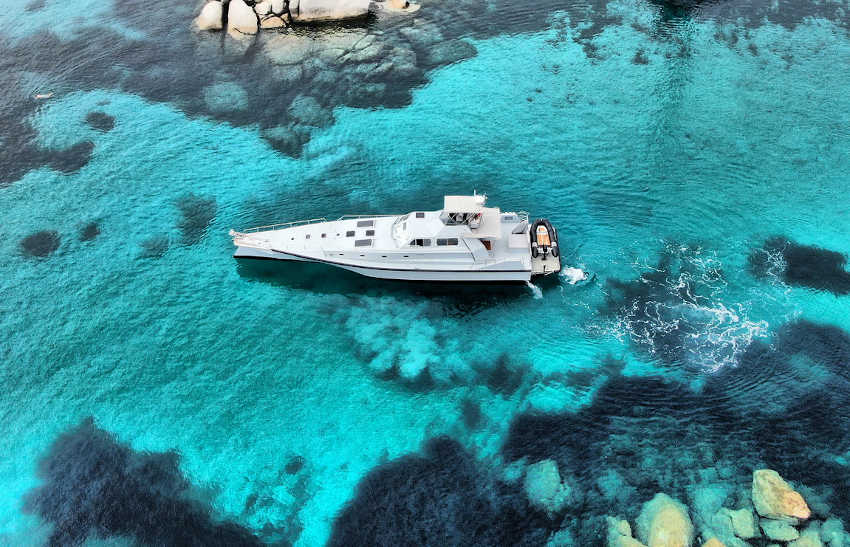
Safehaven sailed from East Ferry Marina in Cork Harbour on the morning of Sunday 15 September to begin the 2,500nm delivery voyage to Sardinia in Italy, which Safehaven Marine MD Frank Kowalski recounts in detail HERE.
Safehaven Marine have shared new video from rough weather sea trials for its latest pilot boat, Dalmore, as well as its new XSV20 named Safehaven.
As previously reported on Afloat.ie, Dalmore is an Interceptor 48 — the 15th of this model, and 40th pilot boat overall for Safehaven Marine — commissioned by the Port of Cromarty Firth in Scotland.
Also on trial was the Cork-based extreme performance boatbuilder’s latest XSV20, which is soon to take up residence in the Bay of Biscay.
Safehaven follows Thunder Child II, the next generation of the piercing monohull class that will now see its world record Transatlantic attempt take place in summer 2020 — thanks in part to the busy business’ full order book this year.
Safehaven Marine’s latest Interceptor 48 launch is ‘Dalmore’, built for the Port of Cromarty Firth in Scotland.
Powered by a pair of Volvo D13 500hp engines, the pilot boat has an operational speed of 25 knots and accommodates seven crew and pilots.
Dalmore is due for delivery by sea from Cork to Cromarty, north of Inverness, via the Caledonian Canal within the next few weeks.
The new vessel will mark Safehaven’s 40th pilot boat delivery, and the 15th of the successful Interceptor 48 model, “proving how well respected the design is within the industry, with another four on order”.


























